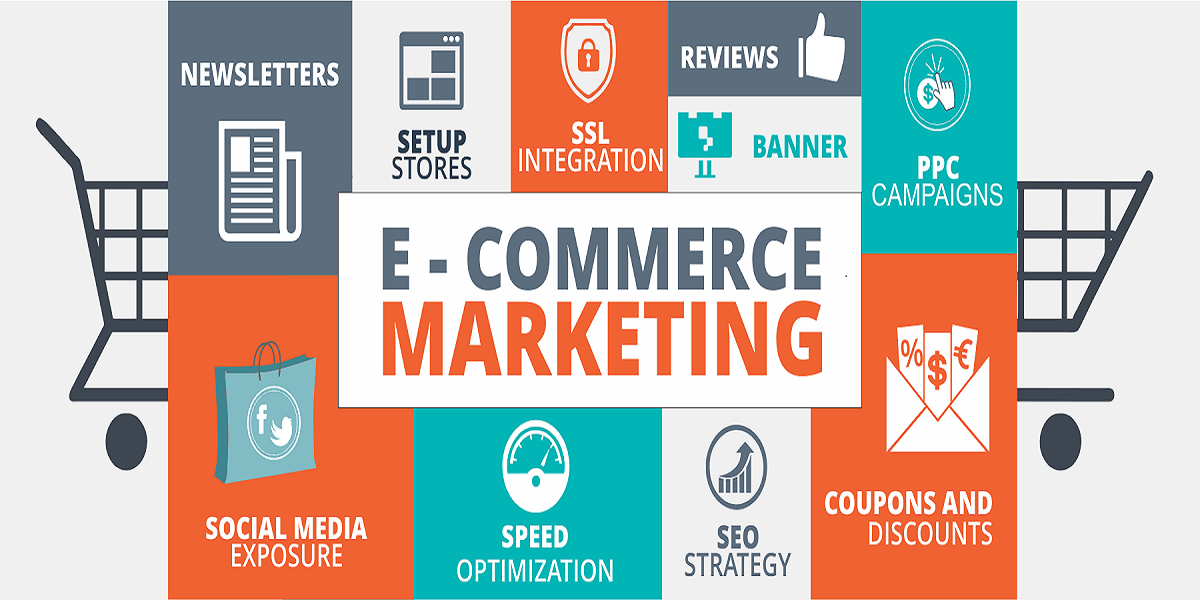
E-commerce Marketing: Types And Strategies To Follow
- By Tanmayi Arora
- 13-05-2020
- E-commerce
Walk the extra mile to sustain in the competition. Which competition? Digital marketing strategies. What is the extra mile? With trillions of sales throughout the globe, the e-commerce platforms are exploding. To sustain in this competition, the only way is to align your business strategies. It is usually the traditional marketing method of hoardings and pamphlets that comes to mind when we talk of marketing. But, no, the hoardings and big banners are not as effective as the visual attention across the digital platforms.
E-commerce marketing follows the ToFu strategy. What is it? It is the top funnel marketing strategy. This involves the conversion of the top funnel level to the purchase level. This form of marketing isn’t carried out at just one platform. But, why? It is because channelizing the branding strategies increases the purchase opportunities.
For every business, one must opt for a suitable marketing strategy. What are all these e-commerce marketing types and strategies that you must follow?
E-commerce Marketing Types
Mostly, e-commerce marketing carried out by all the businesses is a culmination of the various types. Before opting for any method, it is good to consider the marketing trends. The content can work wonders for the business. While the other time, it can be a social media post. The most reliable and opted for e-commerce marketing types include:
Social media marketing (SMM): When you hear the word social media, it is about the fun and amazing content that we consume. This is what social media marketers put to use. Branding the content in a fun way. SMM is a great way to market your products and target audience of all age groups. This further leads to retargeting. This is part of brand awareness. For instance, you can use hashtags on Instagram or LinkedIn to gain audience attention. Similarly, keyword search is also a key strategy to gain views and reach on YouTube and other social media verticals.
Content marketing: One of the main techniques for content marketing is using Pareto’s 80/20 rule. As per this rule, provide 80% informative content and 20% promotional content to the audience. Also, content marketing is one of the key ways to gain the trust of the target audience and build potential customers. Once the customer is convinced and feels that the product offers the right solution to their problem, making them purchase the products becomes easier. You can relate the content to brand storytelling. The better the content, the more the audience.
The various components of content marketing include:
Website and page optimization: Imagine visiting a website and having to wait for a long time for the page to load. Low page speed comes as a disappointment. Or even if the website design isn’t as attractive. It is important to have the website optimized for a user-friendly experience. Increased page speed and a good UX/UI (user-interface) allow audience retention, CTR and on-site time.
Relevant blog posts: Post blog posts in relevance to your products and services. These can include tips, tricks, updates and other things. This allows building the customer’s trust which is a part of capturing the target audience for potential customers.
Guest posts: Posting on other websites with your name is a win-win situation for both. The guest gets the content, and you get the audience. This is a form of re-targeting.
YouTube videos: Most of the time, good visual content connects with the audience immediately. A lot of big brands use videos to convey their message across various digital platforms.
FAQ section: By offering answers to the frequently asked questions of the customers, allow them to purchase the products easily and understand the brand better.
Search engine marketing (SEM): Google is the leading search engine across the globe. Have questions? Google it. But imagine being on the other end. Being the business person instead of the customer. You would want your website or page to rank among the top lists. How is it done? This is where the role of search engine marketing comes into play. It is used to increase the ranking on the SERP (Search Engine Results Page). However, it has several components, which include:
SEO (Search Engine Optimization)
Paid advertisements which include GoogleAds, Facebook, Ads, etc.
Email marketing: Nowadays, the easiest way to reach the audience is through emails. Sending personalized emails allows building the potential customer base. You can use the Google Analytics dashboard to see how well this marketing works for your target audience. It serves mainly two purposes for the e-commerce industry:
Follow-ups after purchase and by sending personalized deals and discounts.
By making the customers purchase the products added in the cart
Influencer marketing: Nowadays, whether it be the youth or grown-ups, everyone ends up spending a lot of time across the digital platforms. In short, consuming digital content. But, who creates this content? They are the influencers or digital creators. The audience trusts what the influencer says. So, instead of putting the marketers put the influencers to use.
Apart from these marketing types, there are several other ways which the marketers opt for. It varies according to business. For a startup and small business, brand awareness is the priority. However, for the well-established brands, it is important to retain their customers and market reputation.
E-commerce Marketing Tips
The drill of marketing techniques and tips does not end here. You can follow some tips that are like the cherry on the top for your marketing strategies.
The list of e-commerce marketing tips includes:
Personalization: While sending emails, it is good to customize them. The CTR (Click Through Rate) increases with personalization. It is a part of capturing the audience and gaining their attention.
UGC (User-generated content): The users themselves help the brand in marketing their products. Coca-Cola used this strategy by sending personalized cola bottles to the people. This strategy is a win-win situation for both the buyers and sellers.
Reviews: A positive brand image is a must. You do not want any retractors for your brand. The reviews allow the buyers to form the right image of the products and let them decide easily.
Live chats: With live chats and 24*7 customer care, you can make the buying process simplified for the customers. This allows us to resolve the customer’s queries instantaneously.
Trustworthy shopping cart and user experience: No one wants to fall in a trap while making the payment. You should offer a secure and encrypted payment option to the customers to build the trust. This is the reason most times, the users end up leaving the products in the cart.
Augmented reality and virtual reality: If you are wondering how AR and VR help in e-commerce marketing? Let’s take an example. Consider that you have a furniture store. With the help of AR and VR, you can help the customers see how the furniture fits at their place of work or home. This allows them to choose the best products. Put this technology to the right use.
Conclusion
In brief, with all the strategies and tips, you can ace the e-commerce marketing game. All you need to do is have a clarity of the business and audience. This makes the tasks easier and well-sorted. As tough as it seems, the more benefits it has. As a web developer and web development company, you have to utilize this article as a kind of perspective. The digital platforms have changed the face of marketing. Even though it requires patience and consistency, the efforts are worth it. With all the marketing tools in hand, have a proper marketing plan. Use the strategy the right way to tackle your online store and nurture it.
Recent blog
.png)
Top 03 Audio Enhancers to Enhance Your Voice in Minutes
Technology | 18-04-2024.png)
Offshore and Nearshore Mobile App Development: A Guide
Mobile App Development | 17-04-2024.png)




